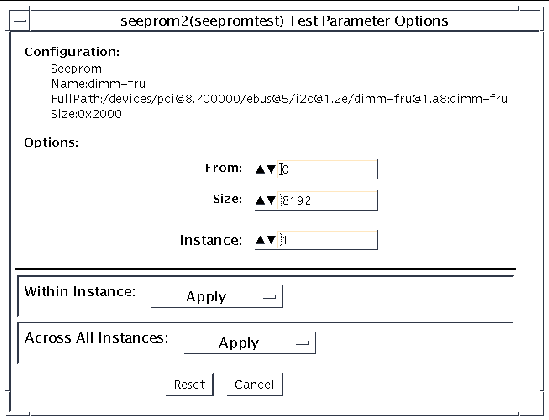| C H A P T E R 51 |
|
SEEPROM Test (seepromtest) |
seepromtest verifies the functionality of the SEEPROM. The probing portion of seepromtest traces the PICL (Platform Information and Control Library) tree and finds the SEEPROM nodes with physical addresses. In addition, the probing portion of seepromtest verifies the size of the physical parent of the SEEPROM. Once the probing portion is complete, seepromtest reads each byte of the SEEPROM devices to verify that the SEEPROM is the correct size. Finally, the seepromtest checks the read operation of the SEEPROM devices.
|
Note - seepromtest can only be performed on platforms with one or more SEEPROM physical address in the PICL tree. Currently, seepromtest is only supported on the Sun Blade 1000/2000 workstations. |
To reach the following dialog box, right-click on the test name in the System Map and select Test Parameter Options. If you do not see this test in the System Map, you might need to expand the collapsed groups, or your system might not include the device appropriate to this test. Refer to the SunVTS User's Guide for more details.

|
Specifies the number from which the offset of the SEEPROM is read. |
|
/opt/SUNWvts/bin/seepromtest standard_arguments [-o
[ dev=device_name ]
[ from=number ]
[ size=number ] ]
SEEPROM devices do not have device names. seepromtest assigns a device name such as seeprom0, seeprom1, seeprom2. If you do not specify a device name in the command-line syntax, the seepromtest lists the device names as seeprom0, seeprom1 or seeprom2, and the physical addresses.
When invoked, seepromtest displays a list of the SEEPROMs in the system and their usage. The following is an example of invoking seepromtest without any arguments. Notice the logical names on the left and physical names on the right.
Copyright © 2006, Sun Microsystems, Inc. All Rights Reserved.